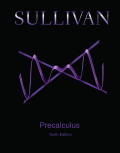
To solve: The function is defined on the interval ,
a. Graph .
In (b)–(e), approximate the area under from 0 to 3 as follows:
To solve: The function is defined on the interval ,
b. Partition into three subintervals of equal length and choose as the left endpoint of each subinterval.
To solve: The function is defined on the interval ,
c. Partition into three subintervals of equal length and choose as the right endpoint of each subinterval.
To solve: The function is defined on the interval ,
d. Partition into six subintervals of equal length and choose as the left endpoint of each subinterval.
To solve: The function is defined on the interval ,
e. Partition into six subintervals of equal length and choose as the right endpoint of each subinterval.
To solve: The function is defined on the interval ,
f. What is the actual area ?
Want to see the full answer?
Check out a sample textbook solution
Chapter 14 Solutions
EBK PRECALCULUS
Additional Math Textbook Solutions
Calculus: Early Transcendentals (2nd Edition)
Thinking Mathematically (6th Edition)
Algebra and Trigonometry (6th Edition)
Elementary Statistics
Pre-Algebra Student Edition
A First Course in Probability (10th Edition)
- (14 points) Let f: R3 R and T: R3. →R³ be defined by f(x, y, z) = ln(x²+ y²+2²), T(p, 0,4)=(psin cos 0, psin sin, pcos). (a) (4 points) Write out the composition g(p, 0, 4) = (foT)(p,, ) explicitly. Then calculate the gradient Vg directly, i.e. without using the chain rule. (b) (4 points) Calculate the gradient Vf(x, y, z) where (x, y, z) = T(p, 0,4). (c) (6 points) Calculate the derivative matrix DT(p, 0, p). Then use the Chain Rule to calculate Vg(r,0,4).arrow_forward(10 points) Let S be the upper hemisphere of the unit sphere x² + y²+2² = 1. Let F(x, y, z) = (x, y, z). Calculate the surface integral J F F-dS. Sarrow_forward(8 points) Calculate the following line integrals. (a) (4 points) F Fds where F(x, y, z) = (x, y, xy) and c(t) = (cost, sint, t), tЄ [0,π] . (b) (4 points) F. Fds where F(x, y, z) = (√xy, e³, xz) where c(t) = (t², t², t), t = [0, 1] .arrow_forward
- review help please and thank you!arrow_forward(10 points) Let S be the surface that is part of the sphere x² + y²+z² = 4 lying below the plane 2√3 and above the plane z-v -√3. Calculate the surface area of S.arrow_forward(8 points) Let D = {(x, y) | 0 ≤ x² + y² ≤4}. Calculate == (x² + y²)³/2dA by making a change of variables to polar coordinates, i.e. x=rcos 0, y = r sin 0.arrow_forward
- x² - y² (10 points) Let f(x,y): = (a) (6 points) For each vector u = (1, 2), calculate the directional derivative Duƒ(1,1). (b) (4 points) Determine all unit vectors u for which Duf(1, 1) = 0.arrow_forwardSolve : X + sin x = 0. By the false positioning numerical methodarrow_forwardSolve: X + sin X = 0 by the false positionining numerical methodarrow_forward
- On from the equation: 2 u = C₁ + C₂ Y + Czy + Cu y³ Find C₁, C₂, C3 and Cy Using these following Cases : (a) 4=0 at y=0 (b) U = U∞ at y = 8 du (c) at Y = S ду --y. ди = 0 at y = 0 бугarrow_forwardTips S ps L 50. lim x2 - 4 x-2x+2 51. lim 22 - X 52. 53. x 0 Answer lim x 0 lim 2-5 X 2x2 2 x² Answer -> 54. lim T - 3x - - 25 +5 b+1 b3b+3 55. lim X x-1 x 1 Answer 56. lim x+2 x 2 x 2 57. lim x²-x-6 x-2 x²+x-2 Answer-> 23-8 58. lim 2-22-2arrow_forwardS 36. lim 5x+2 x-2 37. lim √√2x4 + x² x-3 Answer-> 2x3 +4 38. lim x12 √ x² + 1 √√x² + 8 39. lim x-1 2x+4 Answer 40. lim x3 2x x√x² + 7 √√2x+3arrow_forward
- Algebra & Trigonometry with Analytic GeometryAlgebraISBN:9781133382119Author:SwokowskiPublisher:Cengage
 Algebra: Structure And Method, Book 1AlgebraISBN:9780395977224Author:Richard G. Brown, Mary P. Dolciani, Robert H. Sorgenfrey, William L. ColePublisher:McDougal Littell
Algebra: Structure And Method, Book 1AlgebraISBN:9780395977224Author:Richard G. Brown, Mary P. Dolciani, Robert H. Sorgenfrey, William L. ColePublisher:McDougal Littell

